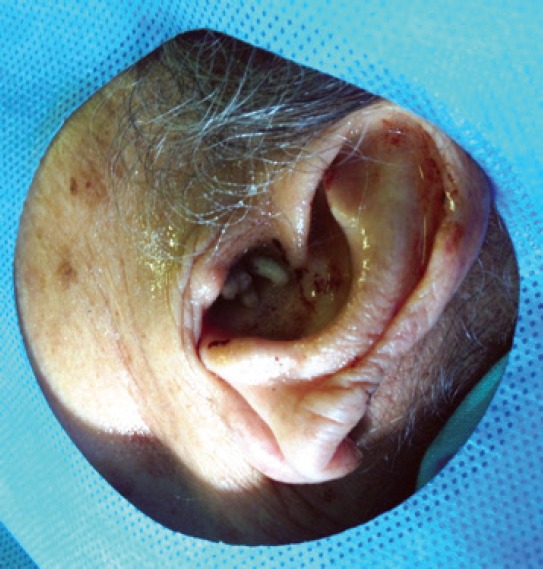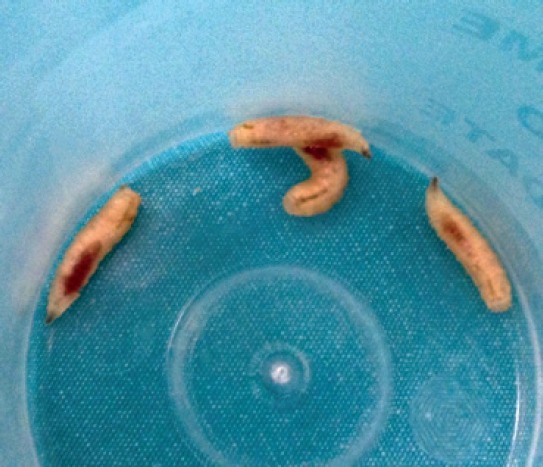Abstract
Myiasis is the infestation of live vertebrates with dipterous larvae. Aural myiasis involves infestation of the external ear and/or middle ear. It is a rare clinical state that usually occurs in patients who have mental or physical disabilities. Although myiasis is a self-limiting disease, it can be associated with fatal complications like penetration within the central nervous system. We present a 87-year-old patient suffering from Alzheimer’s disease with aural myiasis and also discuss the clinical presentation and efective therapies with a review of the literature.
Keywords: Alzheimer’s disease, aural myiasis, otorrhagia
The myiasis, derived from the ancient Greek word ‘myia’ which means fly, is an infestation of the tissues and organs caused by fly (diptera) larvea [1]. Although life cycle of a fly depends on species and types of exposure, usually infestation onsets with flies leaving their ova on intact skin, wound or necrotic tissue. Larvae hatching from the ova pass into adjacent tissues, and complete their life cycles, and transform into adult forms. Myiasis can encounter us in various forms in clinical practice. They are classified as ecologically obligatory, facultative or accidentally localized parasites. Anatomically they are classified according to the location of the larvae in the host [2]. Aural myiasis or automyiasis is the infestation of external ear and/or middle ear with dipterous larvae. This very rarely encountered clinical condition is generally seen in children, in individuals with predisposing factors as mental retardation or impaired personal hygiene. In this article an Alzheimer’s disease patient with automyiasis will be presented after approval of the patient, and their relatives.
CASE REPORT
A 87-year-old bedridden woman for 6 months who followed due to severe dementia and monitored in neurology clinic with the diagnosis of Alzheimer’s disease, was consulted to our clinic because of pruritus and bleeding of her left ear. She was suffering from itching in her left ear for nearly a month and bleeding for 2 days. On her physical examination, left external ear canal was completely occluded with mobile larvae (Figure 1). Then the patient was brought into the operating room for otomicroscopic examination External ear canal was irrigated with 10% lidocaine spray, and 70% ethanol to restrict the movements of larvae. Under microscopic guidance, 7 white-colored, thick, and segmented larvae with a mean length of 10-15 mm were extracted from inside the external ear canal with the aid of an aspirator, and alligator clamps (Figure 2). Secretions, and granulation tissue within the external ear canal were removed. An area of perforation on the posterior quadrant of the tympanic membrane was observed. External ear canal, and middle ear were irrigated with physiologic saline. Larvae were not encountered in the middle ear. Topical antibiotherapy was initiated with a mixture of hydrogen peroxide and boric acid solution One week later larvae were not encountered within her external ear canal. Because of her advanced age, and mental health state tympanoplasty operation was not conceived.
FIGURE 1.

Mobile larvae completely obstructing left external ear canal.
FIGURE 2.

Appearance of live larvae.
DISCUSSION
Myiasis can be seen in various regions, skin, body cavities, and organs. Aural myiasis can manifest itself in various forms including ophthalmomyiasis, nasal myiasis, urogtenital myiasis, intestinal myiasis, and cutaneous myiasis [3-6]. Only one species of dipterous larva can involve more than one anatomical region or different species can be seen in the same region [2].
Otomyiasis is quiet rarely seen in healthy people [7]. Literature reviews have detected its presence generally in children, people with poor hygiene or those having predisposing factors. Among these predisposing factors mental retardation, immobilization, immunosuppression, and diabetes mellitus can be enumerated [8]. Besides chronic otorrhea is considered as a risk factor in healthy, and ambulatory patients [7]. Our case was a bedridden patient for nearly 6 months with a limited interaction with her environment.
Complaints of otomyiasis can manifest differences based on the patient’s mental health state. These patients can present with complaints of sensation of foreign substance in the ear, aural itching, pain, bleeding, tinnitus, hearing loss, and vertigo [8, 9]. In our case, the most important symptom was itching in the ear. However aural pruritus was not considered as an important symptom by her relatives, and the patient was not consulted to an ENT specialist till her left ear bled. This otorrhagic symptom was thought to be related to frequent scratchings, and the patient was fastened to her bed. Since in cases with otomyiasis early diagnosis is thought to be very important, especially in patients with predisposing factors, persistent ear itching should lead the physician to be suspicious of otomyiasis, and the patients should be evaluated with meticulous otoscopic examination.
In literature reviews, the most frequently encountered species of parasites in cases with aural myiasis are cochliomyia hominivorax, wohlfahrtia magnifica, chrysomya bezziana, chrysomya megacephala, and parasarcophaga crassipalpis [2]. In our case segmented larvae measuring approximately 10-15 mm covered with bands of irregularly, and retrogradely arrayed spinous processes. With these characteristics, these larvae were determined to be consistent with wohlfahrtia magnifica species.
Otomyiasis is generally a self limiting disease. Larvae usually leave the host when they become adult larvae. However during this period because of both mechanical effects of larvae, and collagenases they secrete, they induce many complications in the patient. These complications can include perforation of the tympanic membrane, destruction of the middle ear, and mastoid cavity, and fatal central nervous system invasion [10]. Mortality rates of otomyiasis combined with nasal myiasis climb to 8 percent [2]. The most important point in the prevention of complications is early diagnosis, and eradication of the larvae as soon as possible. The treatment of otomyiasis is basically mechanical cleaning of the airway. This procedure should be performed under microscope is especially important in the evaluation of the middle ear in cases with tympanic membrane perforation. Following mechanical cleaning irrigation of the ear canal with 70% ethanol, 10% chloroform or physiologic saline, urea, dextrose, creatinine, and topical ivermectin is recommended so as to get rid of the remaining larvae. In addition, in cases with suspect furuncle or secondary infection, topical antibiotherapy can be prescribed [8-10].
In conclusion, persistent ear itching, and pain, and irritability especially in patients with predisposing factors as mental retardation, dementia, and immunosuppression, oto myiasis should be kept in mind. A simple autoscopic examination may be a life-saving procedure.
Footnotes
Conflict of Interest: No conflict of interest was declared by the authors.
Financial Disclosure: The authors declared that this study has received no financial support.
REFERENCES
- 1.Hope FW. On insects and their larvae occasionally found in the human body. Trans. R. Entomol. Soc. Lond. 1840:256–71. [Google Scholar]
- 2.Francesconi F, Lupi O. Myiasis. Clin Microbiol Rev. 2012;25:79–105. doi: 10.1128/CMR.00010-11. [DOI] [PMC free article] [PubMed] [Google Scholar]
- 3.Arora S, Sharma JK, Pippal SK, Sethi Y, Yadav A. Clinical etiology of myiasis in ENT: a reterograde period--interval study. Braz J Otorhinolaryngol. 2009;75:356–61. doi: 10.1016/S1808-8694(15)30651-0. [DOI] [PMC free article] [PubMed] [Google Scholar]
- 4.Eyigör H, Dost T, Dayanir V, Başak S, Eren H. A case of naso-ophthalmic myiasis. Kulak Burun Bogaz Ihtis Derg. 2008;18:371–3. [PubMed] [Google Scholar]
- 5.Aydin E, Uysal S, Akkuzu B, Can F. Nasal myiasis by fruit fly larvae: a case report. Eur Arch Otorhinolaryngol. 2006;263:1142–3. doi: 10.1007/s00405-006-0112-0. [DOI] [PubMed] [Google Scholar]
- 6.Karabiber H, Oguzkurt DG, Dogan DG, Aktas M, Selimoglu MA. An unusual cause of rectal bleeding: intestinal myiasis. J Pediatr Gastroenterol Nutr. 2010;51:530–1. doi: 10.1097/MPG.0b013e3181eb313c. [DOI] [PubMed] [Google Scholar]
- 7.Hatten K, Gulleth Y, Meyer T, Eisenman DJ. Myiasis of the external and middle ear. Ann Otol Rhinol Laryngol. 2010;119:436–8. doi: 10.1177/000348941011900702. [DOI] [PubMed] [Google Scholar]
- 8.Güler S, Sağıt M, Sarı K, Somdaş MA. An Aural Myiasis on the Grounds of Chronic Otitis Media: Case Report. KBB ve BBC Dergisi. 2011;19:172–5. [Google Scholar]
- 9.Karaman E, Samasti M, Saritzali G, Ozdemir S, Halil MC, Isildak H. Otomyiasis by Wohlfahrtia magnifica. J Craniofac Surg. 2009;20:2123–4. doi: 10.1097/SCS.0b013e3181bec66e. [DOI] [PubMed] [Google Scholar]
- 10.Werminghaus P, Hoffmann TK, Mehlhorn H, Bas M. Aural myiasis in a patient with Alzheimer’s disease. Eur Arch Otorhinolaryngol. 2008;265:851–3. doi: 10.1007/s00405-007-0535-2. [DOI] [PubMed] [Google Scholar]


